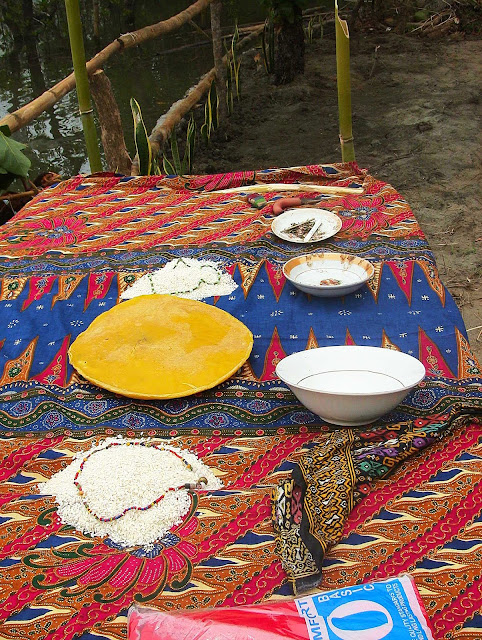Palawan is the home of eight cultural minorities Tao’t Bato (ke’ney), Batac, Pala’wan, Molbog, Mapun, Tausug and Panimusan with diversified customs, traditions, idiosyncrasies and lifestyles.
Before the arrival of the Spaniards, Palawan was under the dominion of the Sultan of Sulu and Borneo who continued to hold sovereignty over the southern part of Palawan until the 19th century making Aborlan a sultanate of Sulu. A political structure formed the government of the early Tagbanuas. The Sultan was represented by a “Masicampo”, the highest ranking tribal leader or the chieftain. He was chosen from a lineage of “Masicampo”, from a particular bloodline. The whole native populace was under his rule. Everybody ran to him for problem-solving, decision making and many other cases. He also appoint the “saribangsawan” and his panglima, maradja and their assistants.
The Tagbanuas have distinct cultural customs and traditions acquired from the people of Sulu and Borneo. (The festival and ritual practices of the Tagbanua of Aborlan, its implication to education. Reynaldo M. Yap Jr., 1994 )
The Sultanate of Brunei ruled during the fourteenth to the sixteenth century CE. Its territory covered the northern part of Borneo and the southern Philippines (wikipedia.com/history of Brunei).
Fragmentary pre- Spanish records denote an early relationship between the west central Philippines, including Palawan, Brunei, and North Borneo. Brunei was an important colony of the Buddhist Kingdom of the Shri- Vishaya in the 12th Century and of the Brahman Empire of Madjapahit in the 14th Century. Although it is not known how extensive were the efforts of the pre- Muslim Bornean Chiefs from Brunei to colonize the southern Philippines, ancient, apparently pre- Spanish manuscripts have been found in the Philippines which refer to Bornean chiefs in Panay, Mindoro, Southern Luzon, and Palawan.
The folk history of the Tagbanuwa also denotes an early relationship with Brunei. According to Clemente Bulunan of Baraki, the first Masicampo of Tagbanuwa was appointed by a surutan (Sultan) of Brunyu, from a land called Burnay (Brunei), eleven generations ago.
The political and juridical powers of the hereditary leaders, which form a hierarchy headed by the Masikampu, extend through the Tagbanua world. Tagbanua society is stratified on the basis of “high bloods” that are the hereditary leaders, the ginuu and their relatives, as well as most of the babalyans or "mediums" and their kin. The remaining persons form a class of “low blood”. In the past there was also a small class of servile debtors, the uripun, who had a slave-like status.
The hereditary leaders often assume responsibilities normally associated elsewhere in the Philippines, such as “marriage counseling”. In legal conflict, the “high bloods” enjoy a marked advantage over the “low bloods” for the latter do not have any kinsmen, as hereditary leaders, to whom they can turn for legal aid.
The highest jural and political office among the Tagbanua is the Masikampu. Regardless of the Spanish origin of this term and the fact that the Spaniards had no intense contact with the Tagbanuas until about 1872, the folk history of the Tagbanua indicates that the function of this office are at least one hundred and fifty years old and probably older.
The Tagbanua society is still stratified but the present “high bloods” have few privileges. There is no class distinction in wealth. Some of the political functions of the hereditary leaders have been assumed by Christian Filipino Officials; moreover “low bloods” have sometimes been appointed to responsible positions by Filipino Officials. (Religion and Society among the Tagbanua of Palawan Island, Philippines. Dr. Robert B. Fox, 1982).
Ruben C. Joya is the 18th anointed Masikampo in the succession line of the Inagawan Masikampu. After being chosen by the council of elders, also known as the Usba e't Masikampo, he assumed his duties and responsibilities following a ritual called the "Lambay". Shown is the ceremony and the paraphernalia used.
 |
| On the table are some of the ceremonial objects during the lambay. Milled rice with the Babaylan (priest/priestess) beads, Natural beeswax (yellow), ceramic bowls, tobacco/cigarette, a cloth we call "patadyong". |
 |
| Tobacco leaves/cigarette, ceremonial knife, wood and a Babaylan's stone/"mutya". |
 |
| Shown above is the stoneware jar with ceremonial rice wine called "Tabad" fermented for weeks, bamboo sticks to drink from the jar. |
 |
| Wild herbs and coconut husks to use as local incense. |
 |
| Chicken or an animal to sacrifice. |
 |
| Babaylan performing ritual prayers |
 |
| The Babaylans in red and Masikampo Ruben C. Joya with the sword called "Badung". |
 |
| The 18th Masikampo of the tribe, Masikampo Ruben C. Joya. |











Comments
Post a Comment